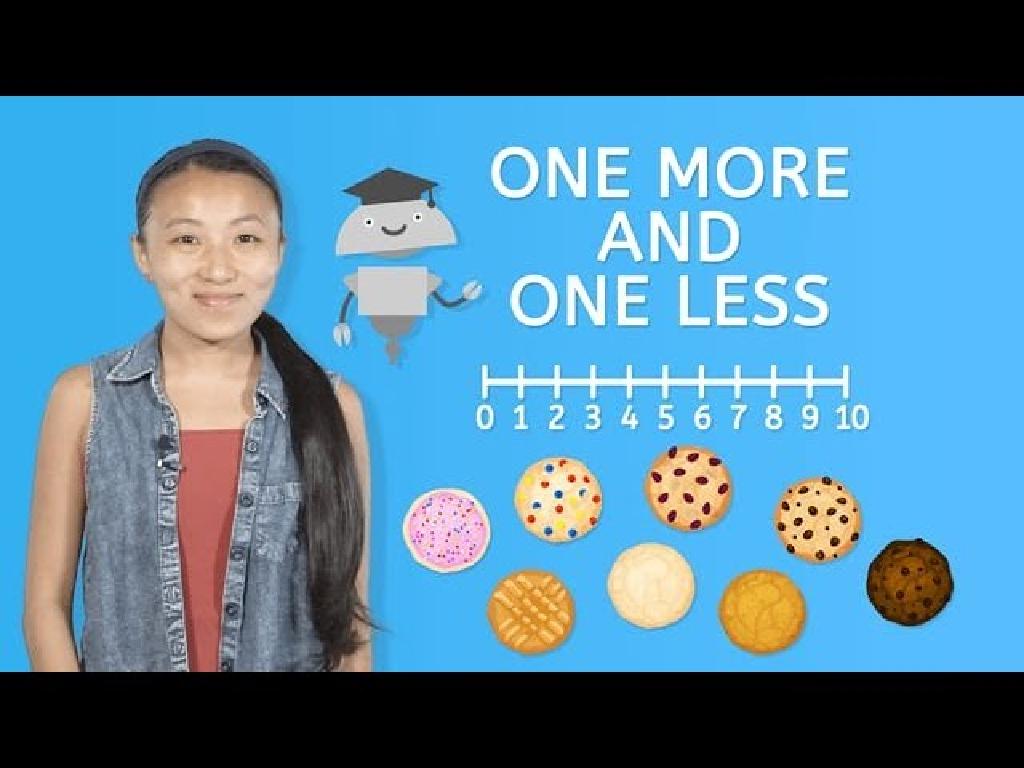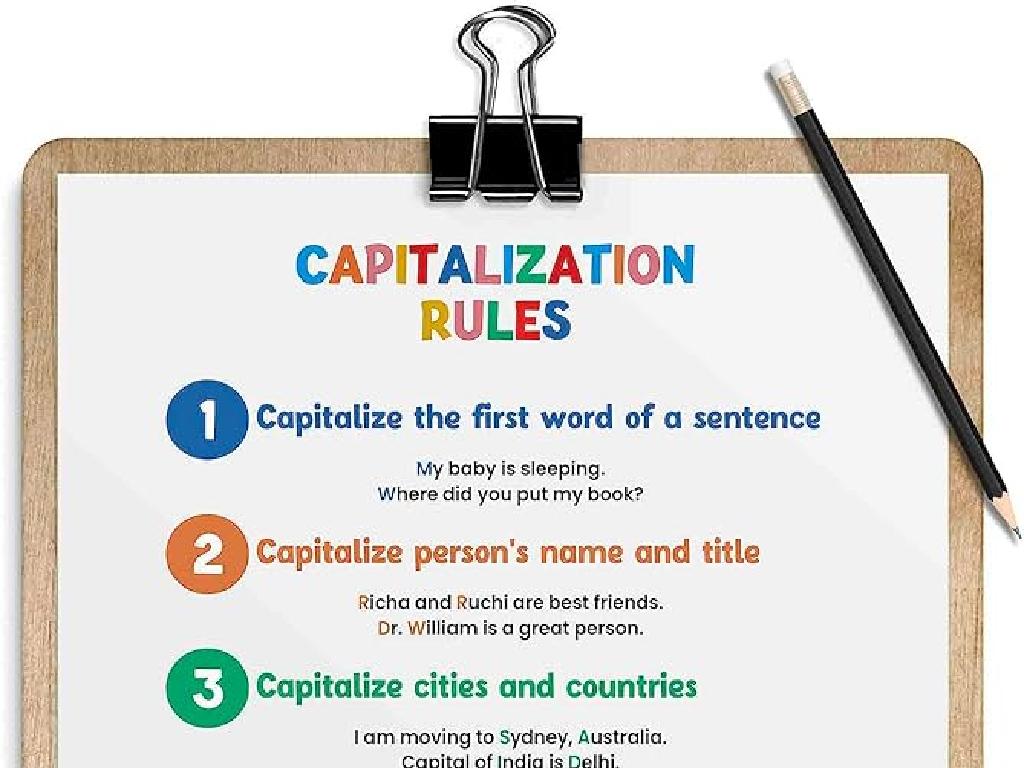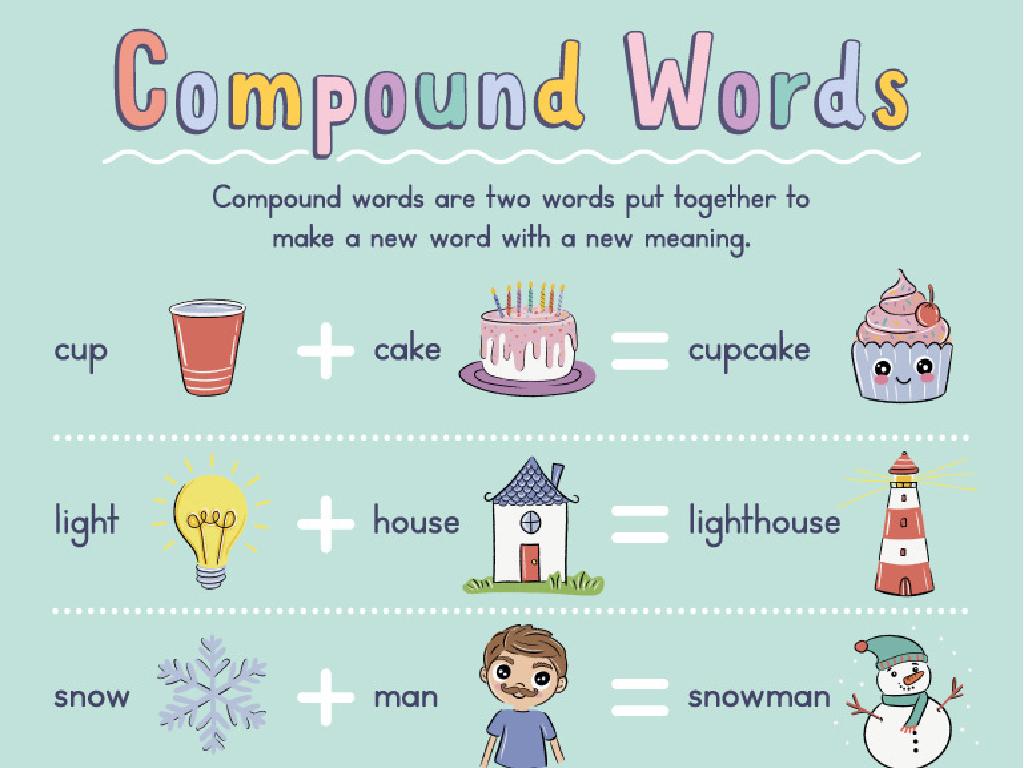Graph Equivalent Fractions On Number Lines
Subject: Math
Grade: Fourth grade
Topic: Equivalent Fractions
Please LOG IN to download the presentation. Access is available to registered users only.
View More Content
Graphing Equivalent Fractions on Number Lines
– What is a fraction?
– A fraction represents a part of a whole.
– Exploring equivalent fractions
– Fractions with different numbers that represent the same value.
– Graphing on number lines
– Placing fractions on a line to show their value.
– Today’s learning goal
|
Begin the lesson by explaining the basic concept of a fraction as a part of a whole, using simple examples like a pizza cut into slices. Then, introduce the concept of equivalent fractions by showing how different fractions can represent the same portion of a whole. Use visual aids to help students understand this concept. Next, demonstrate how to graph fractions on a number line, emphasizing the importance of spacing and the role of the numerator and denominator. The goal for today’s class is for students to be able to graph equivalent fractions on a number line independently. Encourage students to think of a number line as a tool that helps them see the size of different fractions compared to each other.
Understanding Fractions
– A fraction is part of a whole
– Like a slice of pizza from a whole pizza
– Numerator and denominator explained
– Top number (numerator) is the part you have, bottom number (denominator) is the total parts
– Example: 1/2 as a fraction
– 1/2 means 1 out of 2 equal parts, like cutting an apple into 2 pieces and having one
|
Begin by explaining that a fraction represents a piece of something that is whole, using tangible examples like slices of pizza or pieces of fruit to illustrate the concept. Clarify the roles of the numerator and denominator, ensuring students understand that the numerator indicates how many parts are being considered, while the denominator shows the total number of equal parts in the whole. Use the example of 1/2 to show this visually, perhaps by drawing an apple cut into two equal parts and shaded to show one part is selected. This foundational understanding will be crucial as they learn to graph equivalent fractions on number lines.
Exploring Equivalent Fractions
– What are equivalent fractions?
– Fractions showing the same amount
– They may look different, but they’re the same size
– Example: 1/2 equals 2/4 and 3/6
– These fractions all represent the same part of a whole
– Practice finding equivalents on a number line
– Use a number line to see the fractions line up at the same point
|
This slide introduces the concept of equivalent fractions to fourth-grade students. Begin by explaining that even though equivalent fractions may have different numerators and denominators, they represent the same value or portion of a whole. Use the example provided to show visually how 1/2, 2/4, and 3/6 all occupy the same position on a number line, reinforcing the concept that they are indeed equivalent. Encourage students to draw their own number lines and plot different fractions to find other equivalents. This hands-on activity will help solidify their understanding of the concept.
Graphing Equivalent Fractions on Number Lines
– What is a number line?
– A straight line with numbers placed at equal intervals.
– Placing fractions on a number line
– Fractions represent points between whole numbers.
– Equivalent fractions on the line
– Fractions with different numerators and denominators can represent the same point.
– Practice with examples
– Locate 1/2, 2/4, 3/6 on a number line to see they are the same.
|
This slide introduces students to the concept of number lines and how to graph fractions on them. Begin by explaining that a number line is a visual representation of numbers in a sequence. Show how fractions can be placed on a number line by finding their value between whole numbers. Emphasize that equivalent fractions, although they look different, will occupy the same position on a number line. Provide practice examples, such as graphing 1/2, 2/4, and 3/6, to illustrate that these are equivalent fractions because they all represent the same point on the number line. Encourage students to draw their own number lines and plot various equivalent fractions to reinforce the concept.
Graphing Equivalent Fractions on a Number Line
– Divide number line into equal parts
– If the fraction is 1/4, draw a line divided into 4 equal parts
– Denominator shows number of parts
– The bottom number of a fraction, like 4 in 1/4, tells us to divide the line into 4 parts
– Numerator indicates parts to count
– The top number, our numerator, means we highlight 1 out of the 4 parts
– Practice with different fractions
– Try graphing 1/2, 2/4, 3/6 to see they all show the same point on a line
|
This slide introduces students to the concept of graphing fractions on a number line. Start by explaining that a number line must be divided into equal parts, which the denominator of the fraction determines. The numerator tells us how many of those equal parts to count or highlight. It’s crucial to provide examples with different fractions that are equivalent to reinforce the concept that they represent the same point on the number line. Encourage students to practice with various fractions to gain confidence in graphing them. This visual representation helps students understand the concept of equivalent fractions more concretely.
Graphing Equivalent Fractions on Number Lines
– Equivalent fractions explained
– Fractions that represent the same value
– Graph 1/2 on a number line
– Find the midpoint between 0 and 1
– Graph 2/4 on the same line
– 2/4 also represents the midpoint
– Graph 3/6 and compare
– 3/6 is another name for 1/2
|
This slide introduces students to the concept of equivalent fractions using a number line as a visual aid. Start by explaining that equivalent fractions are different fractions that represent the same value. Show how to graph 1/2 on a number line by marking the midpoint between 0 and 1. Then, graph 2/4 and 3/6 on the same number line, emphasizing that they all represent the same point. This visual representation helps students understand that although the numerators and denominators may be different, the fractions are equivalent because they take up the same position on the number line. Encourage students to practice with other fractions and to check their equivalence by graphing them.
Class Activity: Exploring Equivalent Fractions
– Partner up to find equivalents of 1/3
– Graph fractions on a number line
– Place your fractions correctly on the line
– Discuss your findings with your partner
– How did you determine they were equivalent?
– Present your fractions to the class
|
This interactive class activity is designed to help students understand the concept of equivalent fractions by working in pairs to find different fractions that are equivalent to 1/3. Provide each pair with a number line and have them plot their findings. Encourage discussion between partners to reinforce their understanding. After plotting, each pair will share their equivalent fractions with the class, explaining how they determined the equivalency. Possible activities include: using fraction strips, drawing pie charts, or using real-life objects to visualize fractions. This will help students grasp the concept that different fractions can represent the same value.
Review and Reflect: Equivalent Fractions on Number Lines
– Understanding equivalent fractions
– Fractions that have the same value, even if they look different
– Graphing fractions on a number line
– Place fractions on a line to see their value. Each space is a fraction of a whole
– The usefulness of graphing fractions
– It helps compare sizes and understand fractions better
|
Today’s lesson focused on equivalent fractions, which are different fractions that represent the same part of a whole. We learned how to identify and create equivalent fractions. Then, we practiced graphing these fractions on a number line, which helps us visualize and compare the size of different fractions. This is a useful skill because it allows students to understand the concept of equivalence in a concrete way, making it easier to work with fractions in various math problems. Encourage students to reflect on how this method can be applied in real-life situations, such as dividing a pizza among friends or measuring ingredients for a recipe.
Homework Challenge: Graphing Equivalent Fractions
– Practice graphing equivalent fractions
– Use fractions: 1/4, 2/8, 4/16
– Draw them on a number line
– Mark equal spaces on the line, place fractions at the correct points
– Share your graphs in class tomorrow
|
This homework task is designed to reinforce the concept of equivalent fractions by having students practice graphing them on a number line. By using the fractions 1/4, 2/8, and 4/16, students will be able to see how these different fractions represent the same point on a number line, thereby understanding the concept of equivalency. Encourage students to evenly space out the number line and accurately place each fraction in the correct location. In the next class, ask students to present their number line graphs and explain how they determined where to place each fraction. This will help assess their understanding and ability to communicate mathematical concepts.





